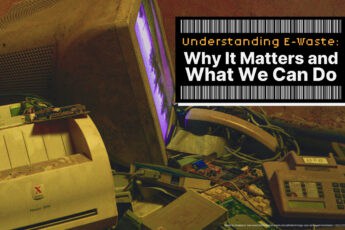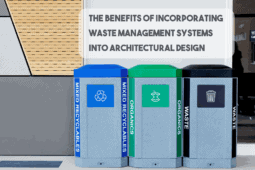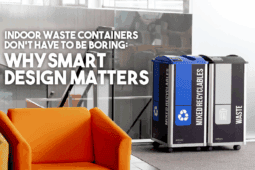Having an effective recycling and waste management program at your retail store will not only reduce your store’s environmental footprint, but also help you cut costs, improve your brand image, and align with customer values. Here are 7 key tips we’ve gathered that will help you build the retail recycling and waste program you’ve always wanted and save you money in the process.
Let’s start with the facts.
There are many different factors that can impact the performance of the recycling and waste program at your retail store. For retailers, the store should be a representation of the company’s values and best qualities, including a strong product assortment and a commitment to more sustainable operations. By running a retail recycling program, you can help ensure that the amount of waste that ends up in landfills is reduced, and that recyclable items are turned into new products.
- In a National Solid Waste Benchmarking Study conducted in 2014, 1,012 retail stores, offices and retail centers across Canada produced an average diversion rate of 54.75%.
- In the same study, Retail Stores were found to have an average diversion rate of 66.71%, while Retail Centers averaged 42.33%.
- The largest composition of divertible materials recovered at retail stores, offices and retail centers are as follows: 64.8% Cardboard, 14.14% Organics, 8.12% Paper, 4.62% Mixed Plastics, Glass & Metal.
- Shoppers worldwide are estimated to be using upwards of 1 trillion single-use plastic bags per year.
- Recent studies estimate there are over 170 trillion pieces of plastic floating in the world’s oceans
At a time when consumers are highly motivated to associate with companies that are committed to sustainability, it’s essential for every retail store to have an effective recycling program in place. An effective program focuses on reducing waste, reusing useful materials and recycling them. Ineffective retail collection programs often result in significant amounts of waste being sent to landfills, leading to high disposal costs. Let’s look at 7 ways you can enhance the effectiveness of your in-store waste management program:
1. Always begin with a preliminary waste audit to categorize and quantify your waste
The first step in building a successful program is to identify the types and quantities of waste generated by each part of your business. Use a map of your retail space (including all relevant zones: entrances, bathrooms, checkouts, offices, warehouse, etc.) and identify the waste types produced in each area.
A preliminary waste audit gives you clearer insight into the current state of waste in your store—letting you detect specific areas for improvement and optimize your waste-management strategy.
Learn how to perform a waste audit here.
2. Build a Green Team
How much time can your employees dedicate to sustainability initiatives? If it’s limited, forming a Green Team can make all the difference.
A Green Team is a small group of employees whose goal is to educate, empower, and inspire both staff and customers toward sustainable practices. Every new initiative needs a launch campaign and influencers who build momentum across the organisation.
For the Green Team to succeed long-term, they should have formal oversight, measurement and verification tools, and a clearly defined mission.
3. Understand your landlord and partner-up with store managers & facility management staff
If you’re a tenant, you may not always control all the relevant infrastructure. For example, you might not be able to monitor energy use directly or benefit from the savings if utilities are billed per square foot rather than per store. That’s the “split incentive” issue.
To overcome this, progressive retailers open a sustainability dialogue with their landlords. Find the right contact at your key property, explore property-wide initiatives, involve other tenants, and kick off pilot recycling projects you can share as case studies.
Consider shared cost-financing mechanisms or rewards for projects that deliver savings.
4. Modify your operational habits
Your store’s daily operations present plenty of opportunity for waste-management improvements.
Here are some actionable ideas:
- Reduce eCommerce packaging: Nearly every retail operation has an online component, which means shipping materials contribute to your waste footprint. According to Capital One, an estimated 356 billion packages were shipped worldwide in 2023. It’s not always possible, depending on your product, but always be cognizant of how you can reduce the amount of packaging your products use. Here’s a list of some great sustainable packaging options.
- Institute a take-back program: For example, accept used products back from customers. This often delights customers and helps close the loop. Best Buy has implemented a program where customers can trade-in a working device and receive an in-store gift card, as well as offering in-store recycling for batteries and other electronic devices!
- Other entrepreneurs are opening outlets boasting zero waste. Lauren Singer, author of the blog “Trash is for Tossers” has set up Package Free Shop, which ships using packaging that is 100% recyclable and 100% compostable.
- Ex-Amazon employee Tamara Limis establishing The Wally Shop, with fresh food items to be delivered in reusable containers.
- Avoid over-production of marketing and publicity material by reviewing distribution lists and regularly updating databases.
- Skip or minimise disposable catering/coffee-service items: If your store offers coffee or refreshments, avoid buying single-use cups, plates, milk cartons, sugar packets.
- Place recycling bins inside the store, in break rooms, and outside near the entrance so both customers and employees can easily divert waste.
- Encourage surface-level changes: Ask customers if they want a bag rather than assuming they do; work with staff and vendors to phase out disposables; switch to reusable containers for transport packaging; promote refillable water bottles.
5. Re-evaluate Disposal Habits with your Hauler
Historically, waste removal was mostly about collecting mixed materials and sending them to landfills. Times have changed—and your Green Team, facility management/custodial staff, and landlord all have a role to play now.
Before launching your recycling program, identify a hauler. Larger stores may need a dedicated service; often your existing waste hauler offers recycling services—so start by asking. If the property manager handles waste agreements, coordinate accordingly.
Be sure to review pickup locations and ease of access: convenience drives participation. As one study noted, if the trash bin is easier to access than recycling, employees will choose the trash—regardless of corporate goals. Make sure your hauler discussions emphasise proper disposal of divertible materials.
6. Choose the right recycling stations and place them appropriately
When selecting containers for each area in your retail store, numerous factors matter—so this section just covers the essentials. For a successful program you must choose containers and place them well across your site.
For example: if there’s no recycling or organics bin next to a trash bin, customers will likely use whichever bin is closest—which usually means mixing everything in the trash. That leads to high contamination and undermines sorting at your community’s Materials Recovery Facility (MRF).
Key considerations when choosing stations:
-
Placement (ensuring convenience)
-
Capacity (match volume of waste)
-
Restrictive openings (to prevent wrong items)
-
Signage & label customization
Ensure every trash bin has a recycling (and if applicable, organics) bin next to it. Some forward-thinking stores build ‘zero-waste stations’—fewer waste receptacles, more recycling/organics bins. Make recycling convenient: that removes the excuse.
7. Communication is key!
Ensure both employees and customers know about your recycling initiatives—new or existing. Integrate recycling education into employee onboarding. Create clear signs for recycling & waste stations—use pictures of common in-store materials to clarify which stream each item belongs in.
In-store announcements, posters, contests and shelf-strips with recycling information all help raise awareness. In a recent study, shelf strips with in-store recycling information improved customer awareness and education of retail recycling programs.
Also, involve your custodial and property-management staff from the beginning. If janitorial staff don’t understand the value or process, they may unintentionally undermine your program. Since they often know actual user behaviour, including them at the design stage helps anticipate issues—and makes sure you don’t inadvertently increase their workload.
8. Bonus Tip! Track performance with data.
Successful retail diversion programs involve employees, occupants, shoppers—and sometimes visitors. Although there’s no single causation model, ongoing communication helps retailers move toward a reusable recycling blueprint across various retail formats.
Tracking solid-waste diversion is an important environmental and operational performance metric—it yields tangible insight for cost and stakeholder engagement. From there you can expand into more detailed metrics: contamination rate, participation rate, weight collected per day, etc.—all moving you closer to your zero-waste goals.
Start your retail recycling program off right using these seven industry-tested tips. Once you launch, you’ll find even more opportunities for improvement—each small change can increase diversion rates, lower costs, and enhance brand loyalty with both staff and customers.
Need help getting started? These tips are a great start for improving the recycling and waste management at your retail store, but our team can help you implement these suggestions.
Contact us to chat with our Retail Recycling Program Specialists for more direction on where to begin your journey to waste management greatness.
Key Takeaways (TL;DR)
-
Start with a waste audit to map out what waste is produced where and how much.
-
Build a Green Team of employees to champion sustainability initiatives and keep momentum going.
-
Partner with your landlord, facility staff, and store managers so you have alignment and access to necessary infrastructure.
-
Change operational habits: reduce packaging, offer take-back programs, eliminate disposable items, and provide convenient recycling bins.
-
Work closely with your waste hauler to ensure recycling streams are collected, contamination is managed, and convenience encourages participation.
-
Choose proper recycling stations: right containers, right placement next to trash, clear signage and capacity that matches usage.
-
Communicate clearly with employees and customers about the recycling program—use signage, onboarding, and visible cues to help correct disposal.
-
Track performance data (diversion rates, contamination, participation) to measure success and continuously improve.
-
When done well, a robust recycling program can reduce landfill waste, save costs, and align your brand with sustainability—a win for business and planet.










